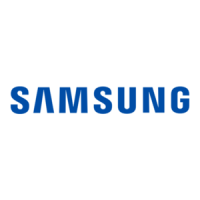41
Conguring the PIP/PBP Settings
Chapter 05
PIP/PBP
The PIP (Picture in Picture) function separates the screen into two parts. One
source device is displayed on the main screen at the same time the another
source device is displayed in inset windows.
The PBP (Picture by Picture) function separates the screen in half displaying output
from two different source devices simultaneously on the left and right sides of the
screen.
―
Compatible with Windows7 and Windows8.
―
The PIP/PBP function may not be available depending on the specifications
of the graphics card used. If the screen is blank in PIP/PBP mode when the
optimum resolution is selected, go to Control Panel
Display Screen
Resolution and click Detect on the PC. (Instructions are based on Windows
7.) If the screen is blank when the resolution is set to the optimum resolution,
change the resolution to 1280 x 1024.
―
The screen may flicker briefly or appear after a delay when you enable or
disable the PIP/PBP function or when you change the screen size with the
PIP/PBP function activated.
This can typically arise when a PC and a monitor are connected to two or more
input sources. It has nothing to do with the performance of a monitor.
The issue is mainly caused when the video signals are delayed in transmission
to the monitor depending on the graphics card performance.
―
To maximize the picture quality, it is recommended to use a graphics card that supports 2560 x 1080 resolution.
―
When the PIP/PBP function is enabled, the resolution will not be able to automatically switch to the optimum resolution
due to a compatibility issue between the graphics card and the Windows system.
Set PIP/PBP Mode to Off or manually change the resolution to the optimum resolution using the Windows interface.

